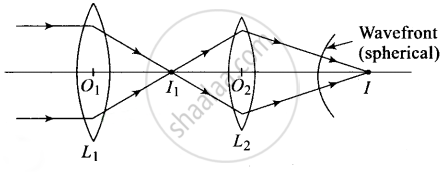Advertisements
Advertisements
Question
Consider a point at the focal point of a convergent lens. Another convergent lens of short focal length is placed on the other side. What is the nature of the wavefronts emerging from the final image?
Solution
Orientation of wavefront is perpendicular to ray. The ray diagram of the situation is shown in figure.

Parallel rays incident on lens L1 forms the image I2 at the focal point of the lens. This image acts as object for the lens L2 Now, due to the converging lens L2 , let final image formed is I which is point image. Hence the wavefront for this image will be of spherical symmetry.
APPEARS IN
RELATED QUESTIONS
Explain the construction of plane wavefront using Huygens’ principle.
What is the shape of the wavefront in the following case?
Light diverging from a point source.
State Huygen's principle.
The refractive indices of water and diamond are `4/3` and 2.42 respectively. Find the speed of light in water and diamond. (c = 3x108 m/s)
When the width of the slit is made double the original width, how would this affect the size and intensity of the central diffraction band?
Huygens' principle of secondary wavelets may be used to
(a) find the velocity of light in vacuum
(b) explain the particle behaviour of light
(c) find the new position of a wavefront
(d) explain Snell's Law
Is Huygen’s principle valid for longitudinal sound waves?
Two light beams of intensities in the ratio of 9 : 4 are allowed to interfere. The ratio of the intensity of maxima and minima ______.
Using Huygen's wave theory of light, show that the angle of incidence is equal to the angle of reflection. Draw a neat and labelled diagram.
Represent diagrammatically how the incident planar wavefronts of wavelength λ pass through an aperture of size d, when d is approximately equal to λ.
